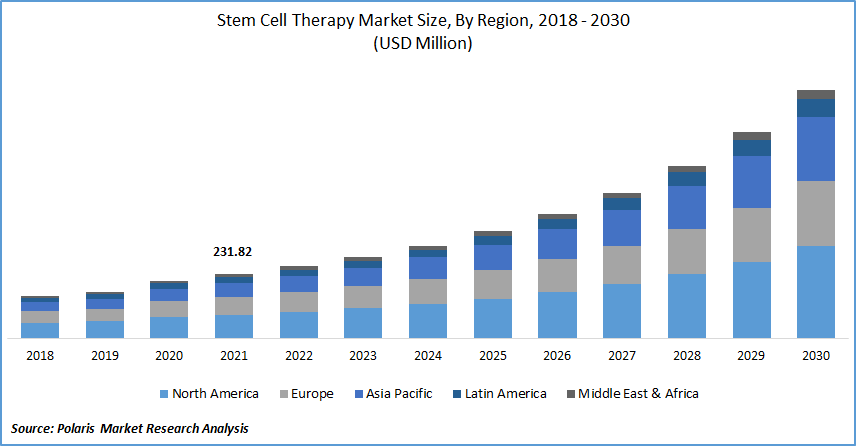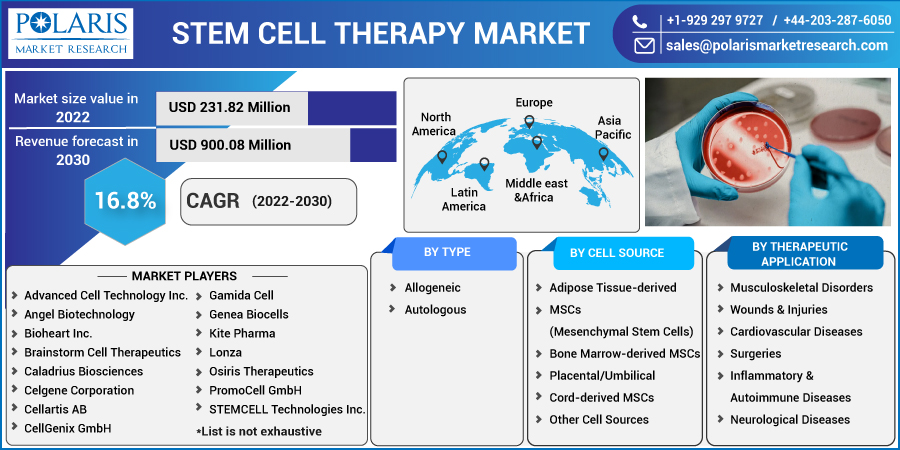
Stem Cell Therapy Market Share, Size, Trends, Industry Analysis Report, By Type (Allogeneic, Autologous); By Cell Source; By Therapeutic Application; By Region; Segment Forecast, 2022 - 2030
- Published Date:Oct-2022
- Pages: 117
- Format: PDF
- Report ID: PM1621
- Base Year: 2021
- Historical Data: 2018 - 2020
Report Outlook
The stem cell therapy market was valued at USD 231.82 million in 2021 and is expected to grow at a CAGR of 16.8% during the forecast period. The rise in cell therapy production facilities, the growing number of precision medicine, and the rising number of clinical trials are some prominent factors responsible for market growth.

Know more about this report: Request for sample pages
An increasing number of clinical trials and approval of stem cell-based therapies from regulatory bodies will create many opportunities for this market. Additionally, rising number of cancer patients worldwide also spurs market growth.
Financial assistance from governments, private vendors, and NGOs drives the market's growth. For instance, National Stem Cell Foundation, a nonprofit, provides funds for research and clinical trials for adult stem cell therapies, education initiatives, and patient advocacy.
Covid-19 has positively influenced the stem cell therapy market, as lung dysfunction was the primary cause of death during the pandemic. For instance, in January 2020, University of Miami researchers administered two infusions of stem cells to COVID-19 patients with lung injury. The results showed no noticeable side effects, and the therapy was effective. Also, according to the article published by BMC, stem cells are safe and effective in treating severe COVID-19 disease, indicating significant potential.
However, limited awareness regarding appropriate treatment and ethical concerns for embryonic stem cells are some factors hampering the market growth. For instance, according to the National Center for Biotechnology Information data, the main elements concerning the population are fear of unknown therapies and lack of awareness about treatment options. Also, decreased adoption due to high costs for the therapies can hinder the market's growth.

Know more about this report: Request for sample pages
Industry Dynamics
Growth Drivers
Increasing technological advancement in stem cell therapeutics, rising demand for stem cell banking, and a growing focus on developing personalized medicines are the primary factors driving the market’s growth.
Increased product launches by key market players are expected to drive the market over the forecast period. For instance, LifeCell, a healthcare service provider, introduced an advanced umbilical cord-stem cell collection kit on August 2017 that protects neonatal stem cells from environmental damage and temperature fluctuations.
Rising chronic disorders are also supposed to accelerate the market's growth. Chronic diseases are common health problems all over the world. One in every three adults worldwide suffers from a chronic condition. Chronic diseases, such as cancer, musculoskeletal and neurologic disorders, chronic injuries, and cardiovascular and gastrointestinal, can result in hospital treatment, long-term disability, decreased quality of life, and death.
Report Segmentation
The market is primarily segmented based on, type, cell source, therapeutic application, and region.
|
By Type |
By Cell Source |
By Therapeutic Application |
By Region |
|
|
|
|
Know more about this report: Request for sample pages
Allogenic type accounted the largest market share in 2021
The allogenic type stem cell therapy acquired the largest market revenue in 2021 as it creates a new immune system for the patients when the donor cells engraft in the recipient. Many malignant and non-cancerous disorders, such as acute leukemia, chronic leukemia, Hodgkin's lymphoma, adrenoleukodystrophy, Bone marrow failure syndromes, and others, can be treated by allogeneic stem cell transplants.
The increasing number of cancer patients has driven the demand for Omidubicel (advanced cell therapy for patients with blood cancer), which is anticipated for the segment's expansion. For instance, in 2022, The MD of Duke Cancer Institute recognized the patients who underwent allogeneic stem cell transplant with the novel cell therapy omidubicel had shown efficacy over standard myeloablative umbilical cord blood in a phase 3 trial (NCT02730299).
Cost-effectiveness and the expansion of stem cell banking have all contributed to the growth of this segment. Furthermore, many cell therapy companies are refocusing on developing allogeneic cell therapy products, which is anticipated to fuel the segment growth.
Adipose tissue-derived MSCs segment acquires the largest market share
Adipose tissue-derived MSCs account most significant market share. The segment’s demand is fueled by associated benefits such as simple isolation procedures, minimally invasive harvesting methods, and a comparatively higher capacity for proliferation.
Adipose-derived stem cells provide various opportunities in the field of tissue engineering and regenerative medicine due to their wide availability and ability to differentiate other tissue types of the mesoderm-including bone, cartilage, muscle, and adipose-ASCs. This application is also anticipated to drive the segment’s growth over the forecast period.
Musculoskeletal disorder segment is expected to hold the significant revenue share
The musculoskeletal disorders segment is anticipated to witness considerable growth over the forecast period. Many musculoskeletal disorders, such as carpal tunnel syndrome, cartilage repair, living cartilage transplant program, ligament repair, orthopedic implant failure, and others, are treated using stem cell therapy.
Stem cells have played an important role in orthopedic regenerative medicine, particularly in healing the body without invasive surgery. Although orthopedic treatment applications in stem cell therapies are still evolving, recent research has shown promising outcomes expected to drive future market growth.
Additionally, the growing demand for mesenchymal stem cells (MSCs) in stem cell therapy has influenced the market’s growth. According to the Journal of Orthopedic Surgery and Research, MSCs are the therapeutic target of biophysical stimulation for treating musculoskeletal disorders.
North America is projected for the largest market share
North America is expected to witness the highest growth over the forecast period owing to the strong biotechnology industry, the dominance of major key players, extensive R&D activities, and the promotion of personalized medicines.
Furthermore, growth in this sector can be attributed to a growing government initiative to promote stem cell therapies. For instance, the Canadian government invested approximately USD 7 million in regenerative medicine and stem cell research in March 2020. It will finance nine transnational projects and four clinical trials in the country to help the country's growth in the regenerative medicine sector.
Competitive Insight
Some of the major players operating in the global market include Advanced Cell Technology Inc., Angel Biotechnology, Bioheart Inc., Brainstorm Cell Therapeutics, Caladrius Biosciences, Celgene Corporation, Cellartis AB, CellGenix GmbH, Cellular Engineering Technologies Inc., Gamida Cell, Genea Biocells, Kite Pharma, Lonza, Osiris Therapeutics, PromoCell GmbH, STEMCELL Technologies Inc., Tigenix, and Waisman Biomanufacturing.
Recent Developments
In February 2021, American CryoStem collaborated with BioTherapeutic Labs Corp for the research and development of stem cells. The main purpose of this collaboration was to develop and improve protocols utilizing CRYO’s ATCell and BTL’s human umbilical cord-based product lines.
April 2024: PromoCell GmbH introduced a Cryo-SFM Plus cryopreservation medium that is able to preserve established cell lines, stem cells, and also primary cells.
January 2024: STEMCELL Technologies, Inc. announced the acquisition of Propagenix Inc. With the acquisition, STEMCELL will be leveraging the EpiX technology of Propagenix Inc. in regenerative medicine to make products based on it.
Stem Cell Therapy Market Report Scope
|
Report Attributes |
Details |
|
Market size value in 2022 |
USD 231.82 million |
|
Revenue forecast in 2030 |
USD 900.08 million |
|
CAGR |
16.8% from 2022 - 2030 |
|
Base year |
2021 |
|
Historical data |
2018 - 2020 |
|
Forecast period |
2022 - 2030 |
|
Quantitative units |
Revenue in USD million and CAGR from 2022 to 2030 |
|
Segments Covered |
By Type, By Cell Source, By Therapeutic Application, By Region |
|
Regional scope |
North America, Europe, Asia Pacific, Latin America; Middle East & Africa |
|
Key Companies |
Advanced Cell Technology Inc., Angel Biotechnology, Bioheart Inc., Brainstorm Cell Therapeutics, Caladrius Biosciences, Celgene Corporation, Cellartis AB, CellGenix GmbH, Cellular Engineering Technologies Inc., Gamida Cell, Genea Biocells, Kite Pharma, Lonza, Osiris Therapeutics, PromoCell GmbH, STEMCELL Technologies Inc., Tigenix, and Waisman Biomanufacturing. |
